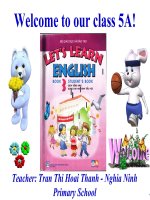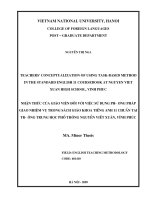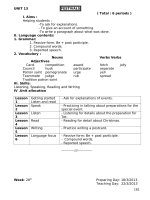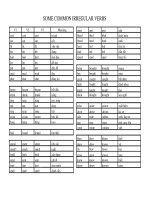unit 13 hobbies tiếng anh 11 trần xuân trường thư viện giáo án điện tử
Bạn đang xem bản rút gọn của tài liệu. Xem và tải ngay bản đầy đủ của tài liệu tại đây (180.79 KB, 13 trang )
<span class='text_page_counter'>(1)</span><div class='page_container' data-page=1>
Date of preparation: March 17th<sub> ,2008 Unit 13 </sub>
Date of teaching: March , 22th , 2008 Period: 79 Lesson: Part A Reading
<b>I.</b> <b>AIMS AND OBJECTIVES : </b>
- <i><b>LANGUAGE CONTENT : </b></i>
+ To introduce to the students some vocabulary about hobbies
+ To develop the students’ reading skills
- <i><b>LANGUAGE FUNCTION:</b></i>
+ To enable the students to scan the text and do some comprehension questions
- <i><b>EDUCATIONAL AIM:</b></i>
+ To help the sts express their hobbies
<b>1. Language:</b>
a. <i>Vocabulary</i>: Noun: glass fish tank
Verb: admire
b. <i>Structure: </i>passive voice
<b>2.Skill: Integrated skills: Pay much attention to reading skills</b>
3.Education factor:
- knowing the importance of hobbies and getting to collect something
<b>II.TEACHER AND STUDENTS’ PREPARATION</b>
1.Method: Communicative Approach
2.Techniques: explanation, question-answer, pair work, groupwork, using pictures
3.Material needed: Pictures, textbook, flash cards,…
4.Students’ preparation: read the lesson at home.
5.Previous exercises: exercises in the workbook
<b>III. PROCEDURE IN CLASS:</b>
<b>1. Stabilization: 3 minutes </b>
A .Warm–up: Greetings
B. Checking absence: Ask the monitor
<b>2.Checking up previous knowledge: </b>
Time needed: omit
Questions:
<b>3.Presentation of the new material: Part A Reading</b>
<b>TIME</b> <b>TEACHER’S ACTIVITIES</b> <b>STUDENTS’ ACTIVITIES</b> <b>THE CONTENT OF THE</b>
<b>LESSON</b>
5’
8’
I
<b> </b><i><b>/Lead in </b></i>
- asks the sts to play the game
“hangman” with the word
“Hobby”
- introduces the lesson
<i><b>II/Pre-reading</b></i>
- has the sts ask and answer some
questions in the textbook to have
general knowledge
- calls on some sts to ask and
answer orally
- remarks
- teaches new words
<b>* Vocabulary</b>
+ glass físh tank [picture]
+ admire [ gap-fill]
Eg: Everyone ……..Uncle Ho for
his contribution to VietNam.
+ throw sth away [miming]
- checks the words’ understanding
- play the game “hangman”
with the word “Hobby”
- listen
- ask and answer
- practise aloud
- listen
- take notes
+ glass físh tank
+ admire
Eg: Everyone ……..Uncle
Ho for his contribution to
VietNam.
+ throw sth away
UNIT 13:
HOBBIES
Part A <i><b>Reading</b></i>
<b>Before you read:</b>
<b>I/New word s </b>
- Glass físh tank
- Admire
Eg: Everyone ……..Uncle Ho
for his contribution to
VietNam.
</div>
<span class='text_page_counter'>(2)</span><div class='page_container' data-page=2>
12’
by asking the students to fill the
gap in these sentences
1. We keep fish in a ………….
2. These clothes are old and out of
fashion. They intend to ……it .
<b>Task 1: Find the Vietnamese</b>
<b>equivalents</b>
- asks the sts to do task 1
individually
- guides the sts how to find words
in a dictionary easily and quickly
- calls on some sts to give answers
- gives feedback
accomplishedWell-trained, skilled
Taøi ba, taøi hoa
Accompanying Going with
a singer, using s musical instrument
đệm (đàn)
Modest Humble, unasuming
Nhỏ, khiêm tốn
Avid Eager Say mê
Discarded Throw away Đã bị bỏ đi
Indulge in Allow oneself the
pleasure of Đam mê
Keep me occupied Keep me
busy Laøm cho tôi bận rộn
1. <i><b>III/ While reading</b></i>
<b>Task 2: Answering questions</b>
- asks the sts to ask and answer in
pairs (5’)
- calls on some sts to practise
- gives remarks
1. His first hobbies is playing the
guitar.
2. No, he isn’t.
3. Because he ‘s an accomplished
guitarist and he is good at
accompanying people singing by
his guitar.
4. His second hobby is keeping
fish.
5. He bought some from the shop
and collected some from the rice
field near his house.
6. he is an avid stamp collector.
7. He collects them fro
mdiscarded envelopes ; his
relatives and friends give him.
8. Local stamps.
9. he keeps the less common ones
inside a small album. The
common ones he usually gives
away to others or if no one wants
them he simply throws them
away.
1. glass fish tank.
2. throw it away
- do task 1
- listen
- answer
- take notes
- ask and answer in pairs
- practise
- take notes
1. His first hobbies is
playing the guitar.
2. No, he isn’t.
3. Because he ‘s an
accomplished guitarist and
he is good at accompanying
people singing by his guitar.
4. His second hobby is
keeping fish.
5. He bought some from the
shop and collected some
from the rice field near his
house.
6. he is an avid stamp
collector.
<b>Task 1</b>
accomplished Well-trained, skilled
Taøi ba, taøi hoa
AccompanyingGoing with a singer,
using s musical instrument đệm
(đàn)
Modest Humble, unasuming
Nhỏ, khiêm tốn
Avid Eager Say mê
Discarded Throw away Đã bị bỏ
đi
Indulge in Allow oneself the
pleasure of Ñam mê
Keep me occupied Keep me
busy Làm cho tôi bận roän
<b>Task 2</b>
1. 1951
2. the 2nd<sub> Asain Games held in</sub>
manila, Philippines
3. 1958
4. squash, rugby, fencing and
mountain biking
5. 2002
<b>Task 2</b>
1. His first hobbies is playing
the guitar.
2. No, he isn’t.
3. Because he ‘s an
accomplished guitarist and he
is good at accompanying
people singing by his guitar.
4. His second hobby is keeping
fish.
5. He bought some from the
shop and collected some from
the rice field near his house.
6. he is an avid stamp collector.
7. He collects them fro
mdiscarded envelopes ; his
relatives and friends give him.
8. Local stamps.
</div>
<span class='text_page_counter'>(3)</span><div class='page_container' data-page=3>
8’
2’
<i><b>IV/ Post reading </b></i>
- asks the sts to work in groups in
5’and talk about their hobbies
- goes around to help
- calls on some sts to present
- gives feedback.
<i><b>V/ Consolidation </b></i>
- reminds the content of the
lesson.
7. He collects them fro
mdiscarded envelopes ; his
relatives and friends give
him.
8. Local stamps.
9. he keeps the less common
ones inside a small album.
The common ones he
usually gives away to others
or if no one wants them he
simply throws them away.
- work in groups in 5’and
talk about their hobbies
- listen
- listen
- listen
away to others or if no one
wants them he simply throws
them away.
<b>1.</b> <b>Home work(3’):</b>
- learn by heart the new words
- translate the text
- do exercises in the workbook
<b>2.</b> <b>Preparation for the next lesson (2’):</b>
-prepare Part B at home (Speaking)
<b>3.</b> <b>Self–evaluation:</b>
</div>
<span class='text_page_counter'>(4)</span><div class='page_container' data-page=4>
Date of preparation: March 20th<sub> , 2008. Unit 13 : </sub>
<b><sub>HOBBIES</sub></b>
Date of teaching: March, 22nd<sub> , 2008 Period: 80 Lesson: Part B Speaking</sub>
<b>I.AIMS AND OBJECTIVES : </b>
- <i><b>LANGUAGE CONTENT : </b></i>
+ To help the sts practise talking about their hobbies
+ To arouse the sts’ interest in collecting something
- <i><b>LANGUAGE FUNCTION:</b></i>
+ To enable the students to talk about their hobbies
- <i><b>EDUCATIONAL AIM:</b></i>
+ To make the sts aware of the importance of hobbies in life
1.
<b> Language:</b>
a. <i>Vocabulary</i>: review vocabulary in the reading text
b. <i>Structure: </i>
2.Skill: Integrated skills: Pay much attention to speaking skills
3.Education factor:
- getting to collect something
<b>II.TEACHER AND STUDENTS’ PREPARATION</b>
1.Method: Communicative Approach
2.Techniques: explanation, question-answer, pair work, group work
3.Material needed: Pictures, textbook,
4.Students’ preparation: read the lesson at home
5.Previous exercises: exercises in the workbook
<b>III. PROCEDURE IN CLASS:</b>
<b>1. Stabilization: 3 minutes </b>
A .Warm–up: Greetings
B. Checking absence: Ask the monitor
<b> 2.Checking up previous knowledge: </b>
Time needed: 5’
Question: ask some questions about the reading text ( page 147)and ask the sts to write some new words
Answer: questions 6,7, 8
<b>3.Presentation of the new material: Part B Speaking</b>
<b>TIME</b> <b>TEACHER’S ACTIVITIES</b> <b>STUDENTS’ ACTIVITIES</b> <b>THE CONTENT OF THE</b>
<b>LESSON</b>
5’
8’
I
<b> </b><i><b>/Lead in </b></i>
- asks the sts to play the game
Describing things (describe some
sports with their own words) [ 4
groups- each group has 4 names of
sports. Who finishes first will be
the winner)
<i><b>II/Pre-speaking</b></i>
- asks the sts what sports they like
most and why
- introduces task 2: Lan and Huong
are talking about Lan’s hobby of
collecting books
- provides some new words
+ second-hand book stall
+ classify
+ tag
+ landscape
- analyses the structure of the
- play the game
- answer
- listen
- take notes
+ second-hand book stall
+ classify
+ tag
+ landscape
- say the structure of the
UNIT 13
Part B <i><b>Speaking</b></i>
<b>Task 1</b>
<b>Which activities do you</b>
<b>like best? Why? </b>
<b>Task 2</b>
* New words
+ second-hand book stall
+ classify
+ tag
+ landscape
</div>
<span class='text_page_counter'>(5)</span><div class='page_container' data-page=5>
12’
7’
2’
dialogue
- calls on two pairs to read aloud
the dialogue
<i><b>III/ While speaking</b></i>
<b>Task 3</b>
- introduces the task, asks the sts to
work in pairs to make a similar
dialogue about collecting stamps
(5’)
- asks different pairs to practise
orally
- gives remarks
<i><b>IV. Post speaking</b></i>
- asks the sts to work in pairs,
talking about their hobby, using
similar structures of task 2
- asks some sts to do the role play
- gives remarks
<i><b>V/ Consolidation </b></i>
- reminds the content of the lesson
dialogue
- read the dialogue
- listen, work in pairs
- practise orally
- listen
- work in pairs, talking
about their hobby
- do the role play
- listen
- listen
<b>4.</b> <b>Home work (3’) - practise speaking at home</b>
<b>5.</b> <b>Preparation for the next lesson(1’) -prepare Part C at home</b>
<b>6.</b> <b>Self–evaluation:</b>
</div>
<span class='text_page_counter'>(6)</span><div class='page_container' data-page=6>
Date of preparation: March, 20th<sub> , 2008. Unit 13: </sub>
HOBBIES
Date of teaching: March, 22nd<sub> , 2008 Period: 81 .Lesson: Part C Listening</sub>
<b>I.AIMS AND OBJECTIVES : </b>
- <i><b>LANGUAGE CONTENT : </b></i>
+ To intoduce to the sts a passage about reading hobby
- <i><b>LANGUAGE FUNCTION:</b></i>
+To help the sts develop listening skills
- <i><b>EDUCATIONAL AIM:</b></i>
+ To help the sts realize the importance of reading books
1. Language:
a. <i>Vocabulary</i>: profitable (adj) <sub></sub> profitably (adv), gigantic (adj), bygone (adj), ignorantly (adv)
b. <i>Structure:</i> simple sentences
2. Skill: listening and speaking
3. Education factor:
- reading books to get knowledge
<b>II.TEACHER AND STUDENTS’ PREPARATION</b>
1.Method: Communicative Approach
2.Techniques: explanation, pair work, group work, guessing
3.Material needed: textbook , cassete
4.Students’ preparation: read the lesson at home
5.Previous exercises: talk about their hobbies
<b>III. PROCEDURE IN CLASS:</b>
<b>1. Stabilization: 3 minutes </b>
A .Warm–up: Greetings
B. Checking absence: Ask the monitor
<b> Checking up previous knowledge: </b>
Time needed: 5’
Questions: asks 2 sts to talk about their hobbies
Answer: textbook (part: speaking)
<b>Presentation of the new material: Part C Listening </b>
<b>TIME</b> <b>TEACHER’S ACTIVITIES</b> <b>STUDENT’S ACTIVITIES</b> <b>THE CONTENT OF THE</b>
<b>LESSON</b>
7’
5’
I
<b> </b><i><b>/Lead in </b></i>
- asks the sts to play the guessing
game ( teacher hides a book in a
box, then asks a student to go to the
board, feel the book and express in
English. The one who gives the right
answer first will be the winner)
- leads to the lesson
<i><b>II. Pre listening</b></i>
- asks the sts to list 3 benefits of
reading books, then share them with
their partners
- writes on the board
- asks the students to pay attention
to words in “Listen and Repeat”
- gives them the words’ meaning
+ gigantic (adj) [ synonym]
+ fairy tale (n) [ real object]
+ profitably (adv) [ translation]
+ bygone (adj) [ example]
- play the guessing game
- listen
- list 3 benefits of reading
books
- take notes
- pay attention to words in
“Listen and repeat” and write
down
+ gigantic (adj)
+ fairy tale (n)
+ profitably (adv)
+ bygone (adj)
UNIT 13
Part C <i><b>Listening</b></i>
</div>
<span class='text_page_counter'>(7)</span><div class='page_container' data-page=7>
14’
7’
2’
- asks the sts to listen and repeat
after the teacher twice.
- calls on some sts to read them
aloud.
<i><b>III/ While listening</b></i>
<b>Task 1 </b>
- introduces task 1
- asks the sts to read task 1
(true-false sentences) in 1’
- reads through the sentences once
- asks the sts to guess the answer
- plays the tape twice
- asks the sts to exchange answers
- calls on some sts to answer
- gives feedback (plays the tape and
pause at the key sentences)
1. T; 2. F; 3. F; 4. F; 5. T; 6. T; 7. T;
8. F
<b>Task 2</b>
- asks the sts to read the task in 2’
- asks them to guess the answers
- asks the sts to listen to the tape
again, then answer orally
- plays the tape twice (if necessary)
- calls on some students to answer,
asks others to remark
- gives feedback.
1. wonderful
2. disease
3. jungle
4. certainly
5. ignorantly
<i><b>IV/ Post listening</b></i>
- asks the sts to work in groups to
talk about the disadvantages of
over-reading
- calls on some sts to answer
- remarks, gives feedback
+ be short-sighted
+ waste money, time
+ not have time for other activities
+ be lazy
+ have headache, etc
<i><b>V. Consolidation</b></i>
- reminds the content of the lesson
-read the words aloud
- listen
- read the sentences in task 1,
pay attention to key words.
- listen
- guess the answer
- listen and do the task.
- exchange answer, take
notes.
- answer
- take notes
1. T; 2. F; 3. F; 4. F; 5. T; 6.
T; 7. T; 8. F
- read the paragraph in task 2
- guess the answer
- listen to the tape
- answer
- take notes
1. wonderful
2. disease
3. jungle
4. certainly
5. ignorantly
- work in groups, talk about
the disadvantages of
over-reading
- answer
- listen, take notes
+ be short-sighted
+ waste money, time
+ not have time for other
activities
+ be lazy
+ have headache, etc
- listen
<b>While you listen</b>
<b>Task 1:</b>
1. T; 2. F; 3. F; 4. F; 5. T; 6.
T; 7. T; 8. F
<b>Task 2</b>
1. wonderful
2. disease
3. jungle
4. certainly
5. ignorantly
<b>Post listening</b>
+ be short-sighted
+ waste money, time
+ not have time for other
activities
+ be lazy
+ have headache, etc
<b>a. Home work :(3’)</b>
- write a passage, summarise the main ideas from the listening task
<b>b. Preparation for the next lesson: (1’)</b>
- prepare Part D at home (how to write a collection )
<b>Self–evaluation:</b>
...
Date of preparation: March, 25th<sub> , 2008. Unit 13: </sub><sub>hobbies</sub>
</div>
<span class='text_page_counter'>(8)</span><div class='page_container' data-page=8>
- <i><b>LANGUAGE CONTENT : </b></i>
+ To help the sts to write a paragraph about hobbies
- <i><b>LANGUAGE FUNCTION:</b></i>
- To enable the students to write a paragraph telling about their hobbies
- <i><b>EDUCATIONAL AIM:</b></i>
- To help the sts understand the importance and pleasure of collecting something
<b>1. Language:</b>
a. <i>Vocabulary</i>:
b. <i>Structure: </i>simple past, present tenses
<b>2.Skill: writing</b>
<b>3.Education factor: knowing more about the value of reading books</b>
<b>II.TEACHER AND STUDENTS’ PREPARATION</b>
1.Method: Communicative Approach
2.Techniques: explanation, question-answer,
3.Material needed: textbook, reference book
4.Students’ preparation: read the lesson at home and review vocabulary about hobbies
5.Previous exercises: talk about the benefits and effects of over-reading
<b>III. PROCEDURE IN CLASS:</b>
<b>1. Stabilization: 2 minutes </b>
A . Warm–up: Greetings
B. Checking absence: Ask the monitor: “Who is absent today?”
<b> Checking up previous knowledge: </b>
Time needed: 6’
Questions: talk about the benefits and effects of over-reading
Answer: previous lesson plan
<b>Presentation of the new material: Part D Writing </b>
<b>TIME</b> <b>TEACHER’S ACTIVITIES</b> <b>STUDENT’S ACTIVITIES</b> <b>THE CONTENT OF THE</b>
<b>LESSON</b>
5’
10’
I
<b> </b><i><b>/Lead in</b></i>
- asks the sts some questions
“What do you collect? Do you
spend much time for it? Do you
feel happy when doing this?
- leads to the lesson “In today’s
lesson, we will write about a
collection”
<i><b>II. Pre writing </b></i>
- elicits and then provides the sts
with the outline of the writing
+ name of the collection
+ how you collect them (buy them,
ask someone to give them,
exchange them,…)
+ how you keep them
+ when you started your collection
+ how you classify them
+ why you collect them (to relax, to
kill time, to entertain oneself)
+ what you plan for the future
- asks the sts to look at some
activities suggested in the box, the
sample writing
- elicits the tense and the language
used in the passage
- answer the questions
* I collect books. I just
spend time for it in the
summer. Yes, I do.
- listen
- answer, listen to the
teacher and take notes
+ name of the collection
+ how you collect them
(buy them, ask someone to
give them, exchange them,
…)
+ how you keep them
+ when you started your
collection
+ how you classify them
+ why you collect them (to
relax, to kill time, to
entertain oneself)
+ what you plan for the
future
- answer: We use a variety
UNIT 12:
Part D <i><b>Writing</b></i>
<b>Outline</b>
+ name of the collection
+ how you collect them (buy
them, ask someone to give
them, exchange them,…)
+ how you keep them
+ when you started your
collection
+ how you classify them
+ why you collect them (to
relax, to kill time, to entertain
oneself)
</div>
<span class='text_page_counter'>(9)</span><div class='page_container' data-page=9>
10’
8’
- provides some useful language for
description
+ use a variety of tenses
+ firstly/ first of all
+ then/ next
<i><b>III/ While writing</b></i>
- asks the sts to write a paragraph
of telling about their hobbies in 10’
- goes around to help
- asks some sts to read their writing
<i><b>IV/ Post writing </b></i>
- corrects the sts’ writing
of tenses
- write the paragraph in 10’
- ask for help
- read their writing
- listen, correct
<b>Suggested writing</b>
<b>c. Home work (3’):</b>
- write a paragraph (workbook)
<b>d. Preparation for the next lesson ( 1’):</b>
-prepare Part E at home
<b>Self–evaluation:</b>
</div>
<span class='text_page_counter'>(10)</span><div class='page_container' data-page=10>
Date of preparation: March, 26th<sub> , 2008 Unit 12 : </sub>
Date of teaching: March, 29th<sub> , 2008 Period: 83 Lesson: Part E Language Focus</sub>
<b>I.AIMS AND OBJECTIVES : </b>
- <i><b>LANGUAGE CONTENT : </b></i>
+ To help the sts to pronounce the four sounds / pt/, / bd, / ps/, /bz/
+ To introduce to the sts how to use cleft sentence (subject focus, object focus, adverbial focus)
- <i><b>LANGUAGE FUNCTION:</b></i>
+ To enable the students to pronounce four sounds above correctly
+ To help them do some grammar exercises related to cleft sentences
- <i><b>EDUCATIONAL AIM:</b></i>
- To make the students aware of the importance of using correct grammar
<b>1. Language:</b>
a. <i>Vocabulary</i>: review vocabulary learnt
b. <i>Structure:</i> cleft sentences
<b>2.Skill: Integrated skills</b>
<b>3.Education factor: doing grammatical exercises regularly</b>
<b>II.TEACHER AND STUDENTS’ PREPARATION</b>
1.Method: Communicative Approach
2.Techniques: explanation, analysis, question-answer, group work, pair work
3.Material needed: textbook, reference books, hand-outs
4.Students’ preparation: do the exercises at home.
5.Previous exercises: write a paragraph telling about their hobbies
<b>III. PROCEDURE IN CLASS:</b>
<b>1. Stabilization: 2 minutes </b>
A .Warm–up: Greetings
B. Checking absence: Ask the monitor
<b> Checking up previous knowledge: </b>
Time needed: 2’
Questions: asks some students to hand in their notebooks
Answer: teacher checks at home
<b>Presentation of the new material: Part E Language focus</b>
<b>TIME</b> <b>TEACHER’S ACTIVITIES</b> <b>STUDENT’S ACTIVITIES</b> <b>THE CONTENT OF THE LESSON</b>
5’
5’
I
<b> </b><i><b>/Lead in </b></i>
- asks the sts to play the game
“Simon says”[ T will ask the 5
sts to do something, but sts only
follow his order if his command
begins with “please”. When the
teacher doesn’t say “please” at
the beginning of the request, Ss
don’t have to follow it. The
student who has most right
answers will be the winner. ( The
words are: stopped, robbed,
stops, robs)]
- introduces the lesson: “Today
we’ll practise some sounds /
pt/, /bd/, / ps/, / bz/
<b>II. Presentation 1</b>
<b>* Pronounciation</b>
<i><b>Activity 1: Listen and Repeat</b></i>
- reads the words in the text book
- 5 sts join tha game “Simon
says”. Others listen
- listen
- listen
UNIT 13:
HOBBIES
Part E <i><b>Language Focus</b></i>
<b>Pronunciation </b>
/ pt/ / bd/ /ps/ /bz/
Stopped robbed stops robs
Jumped stabbed steps bribes
Stepped grabbed maps rubs
Trapped bribed shops clubs
One of my hobbies is watching TV. My hobby
starts when I was a girl of five. I would always ask
my parents to turn on the TV set so that I could
enjoy the cartoon films or advertisements.
Now I find that watching TV enables me learn
many things. I learn a lot about how people lived
in the old times. I learn about the wonders of the
world, space travel, animals and plants and other
fascinating things.
</div>
<span class='text_page_counter'>(11)</span><div class='page_container' data-page=11>
4’
10’
carefully once, shows them how
to pronounce the sounds
correctly
- asks the sts to read the words in
the textbook after the teacher
- calls on some sts to read the
words
- makes corrections
<i><b>Activity 2: Practise the</b></i>
<i><b>sentences</b></i>
- reads the sentences once and
explains the meaning if
necessary
- asks the sts to work in pairs to
practise reading the sentences.
- calls on some sts to read aloud
- gives comments
<b>III. Presentation 2</b>
<b>* Grammar: Cleft sentences</b>
- draws a girl and her mother on
the board. Her mother is giving
her a book
- asks the sts: What is her mother
doing? (She is giving her
daughter a book)
- introduces the sentence with
“It”
* It was her mother who is
giving a book to her.
- explains: her mother is the
subject of the sentence. To
emphasize, we can begin with “It
was her mother who…
+ Her mother is giving her
daughter a book
+ It was her mother who is
giving a book to her.
- gives another example
(T draws a girl who saw a cat.
Asks: What did the girl see?)
- writes on the board
The girl saw a cat.
- asks: Is the cat here the subject
or object of the sentence?
(object)
- asks the sts to rewrite the
sentence with “It”
- writes on the board
+ It was the cat that the girl saw.
- explains how to write cleft
sentence with object focus.
+ The girl saw the cat.
+ It was the cat that the girl saw.
- expands the second sentence
- read the words in the
textbook after the teacher
- read the words aloud
- listen, repeat if necessary
- listen
- practise reading the
sentences
- practise
- listen
- look at the board
- answer: She is giving her
daughter a book
- listen, take notes
* Her mother is giving her
daughter a book
* It was her mother who is
giving a book to her.
- listen, look at the board
- answer: The girl saw a cat.
- take notes
- answer: object
- rewrite the sentence with “It”
- take notes
+ It was the cat that the girl
saw.
- listen
+ The girl saw the cat.
+ It was the cat that the girl
saw.
- listen, take notes
<b>Grammar: </b>
<b>Cleft sentence: subject of the</b>
<b>sentence</b>
+ Her mother is giving her
daughter a book
+ It was her mother who is
giving a book to her.
<b>Cleft sentence: object of the</b>
<b>sentence</b>
+ It was the cat that the girl
saw.
<b>Cleft sentence: adverbial</b>
<b>modifier of the sentence</b>
</div>
<span class='text_page_counter'>(12)</span><div class='page_container' data-page=12>
5’
5’
5’
+ The girl saw the cat in the
garden. (in the garden: adverbial
modifier)
It was in the garden that the girl
saw the cat.
<b>IV. Practice</b>
<i><b>Exercise 1 </b></i>
- asks the sts to do exercise 1 in
pairs
- goes around to offer help
- calls on some sts to answer
- corrects
1. It was the boy who visited his
uncle last month.
2. It was my mother who bought
me a present on my birthday.
3. It was Huong and Sandra who
sang together at the party.
4. It was nam’s father who got
angry with him.
5. It was the boys who played
football all day long.
6. It was the girl who received a
letter from his friend yesterday.
7. It was his presence at the
meeting that frieghtened the boy.
<i><b>Exercise 2</b></i>
- asks the sts to do the task
individually
- calls on some sts answer orally
- corrects
1. It is English that the man is
learning.
2. It was the book that the
woman gave him.
3. It was the postcard that she
sent her friend.
4. It was the book that Hoa
borrowed from Long.
5. It was his garden whom the
little boy greeted in a strange
language.
6. It was the policeman whom
the pedestrian asked a lot of
questions.
7. It was the stranger whom the
dog barked at.
<i><b>Exercise 3</b></i>
- asks the sts to do exercise 3 in
groups in 2’
- asks the sts to answer orally
- gives feedback
+ The girl saw the cat in the
garden. (in the garden:
adverbial modifier)
- do exercise 1 in 2’
- asks for help
- answer
- take notes
1. It was the boy who visited
his uncle last month.
2. It was my mother who
bought me a present on my
birthday.
3. It was Huong and Sandra
who sang together at the party.
4. It was nam’s father who got
angry with him.
5. It was the boys who played
football all day long.
6. It was the girl who received
a letter from his friend
yesterday.
7. It was his presence at the
meeting that frieghtened the
boy.
- do the task individually
- answer orally
- take notes
1. It is English that the man is
learning.
2. It was the book that the
woman gave him.
3. It was the postcard that she
sent her friend.
4. It was the book that Hoa
borrowed from Long.
5. It was his garden whom the
little boy greeted in a strange
language.
6. It was the policeman whom
the pedestrian asked a lot of
questions.
7. It was the stranger whom
the dog barked at.
- do the task individually
- answer orally
- take notes
1. It was in the garden that the
<b>Exercise 1</b>
1. It was the boy who visited his
uncle last month.
2. It was my mother who bought
me a present on my birthday.
3. It was Huong and Sandra who
sang together at the party.
4. It was nam’s father who got
angry with him.
5. It was the boys who played
football all day long.
6. It was the girl who received a
letter from his friend yesterday.
7. It was his presence at the
meeting that frieghtened the
boy.
<b>Exercise 2 </b>
1. It is English that the man is
learning.
2. It was the book that the
woman gave him.
3. It was the postcard that she
sent her friend.
4. It was the book that Hoa
borrowed from Long.
5. It was his garden whom the
little boy greeted in a strange
language.
6. It was the policeman whom
the pedestrian asked a lot of
questions.
7. It was the stranger whom the
dog barked at.
<b>Exercise 3</b>
</div>
<span class='text_page_counter'>(13)</span><div class='page_container' data-page=13>
1. It was in the garden that the
boy hit the dog.
2. It was for tea that she made
some cakes.
3. It was for him that his father
repaired the bike.
4. It was on his birthday that she
presented him a book.
5. It was in Britain that he met
his wife.
6. It was from the shop that she
bought that present.
7. It was at 8 a.m that the
meeting started.
boy hit the dog.
2. It was for tea that she made
some cakes.
3. It was for him that his
father repaired the bike.
4. It was on his birthday that
she presented him a book.
5. It was in Britain that he met
his wife.
6. It was from the shop that
she bought that present.
7. It was at 8 a.m that the
meeting started.
boy hit the dog.
2. It was for tea that she made
some cakes.
3. It was for him that his father
repaired the bike.
4. It was on his birthday that she
presented him a book.
5. It was in Britain that he met
his wife.
6. It was from the shop that she
bought that present.
7. It was at 8 a.m that the
meeting started.
<b>Homework (1’)</b>
- redo the execises and do some exercises in the workbook
<b>Preparation for the next lesson (1’):</b>
-prepare for the first semester examination
<b>Self–evaluation:</b>
</div>
<!--links-->









